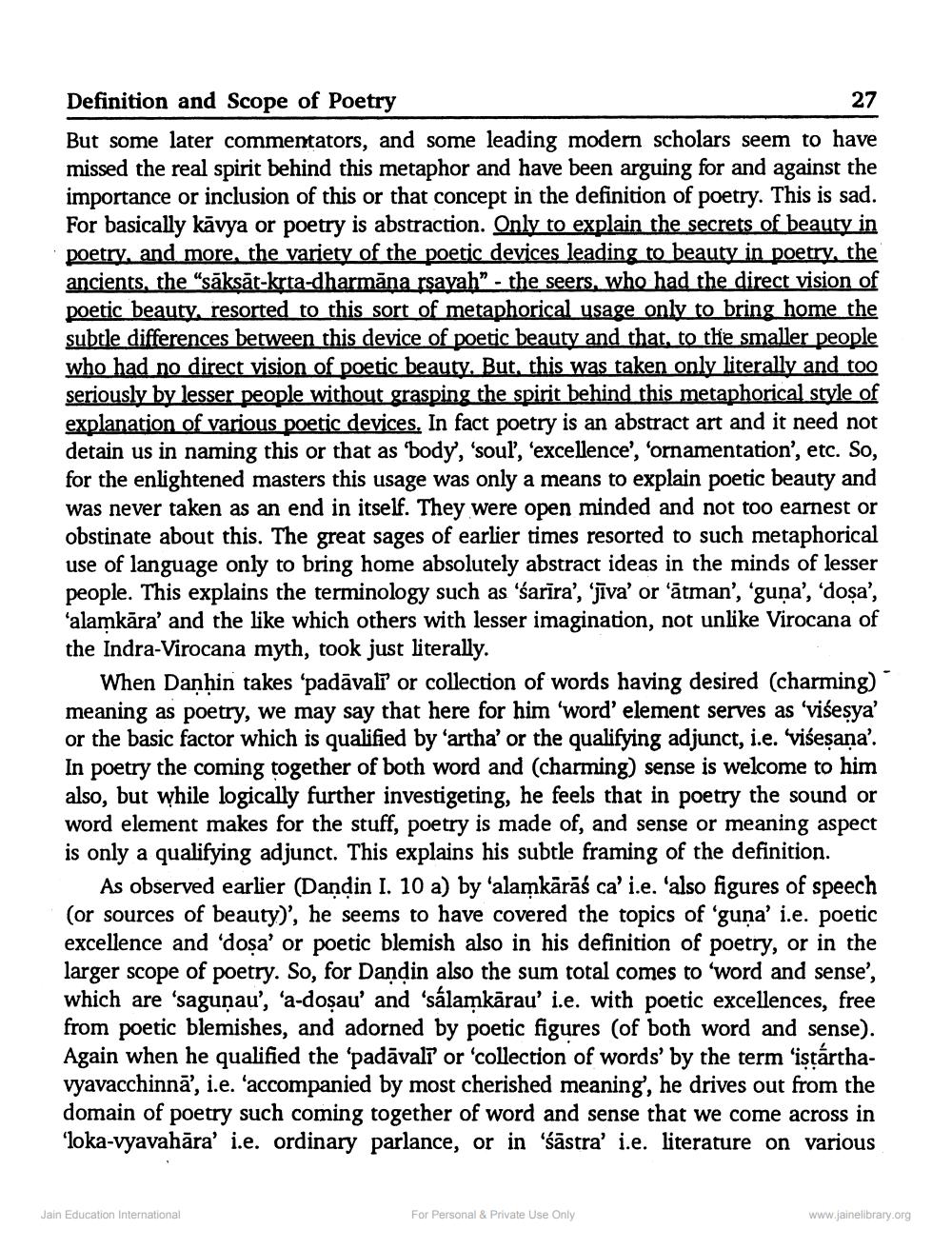________________
Definition and Scope of Poetry
27
But some later commentators, and some leading modern scholars seem to have missed the real spirit behind this metaphor and have been arguing for and against the importance or inclusion of this or that concept in the definition of poetry. This is sad. For basically kävya or poetry is abstraction. Only to explain the secrets of beauty in poetry, and more, the variety of the poetic devices leading to beauty in poetry, the ancients, the "sāksāt-krta-dharmāna rsayah” - the seers, who had the direct vision of poetic beauty, resorted to this sort of metaphorical usage only to bring home the subtle differences between this device of poetic beauty and that, to the smaller people who had no direct vision of poetic beauty. But, this was taken only literally and too seriously by lesser people without grasping the spirit behind this metaphorical style of explanation of various poetic devices, In fact poetry is an abstract art and it need not detain us in naming this or that as 'body', 'soul', 'excellence', 'ornamentation', etc. So, for the enlightened masters this usage was only a means to explain poetic beauty and was never taken as an end in itself. They were open minded and not too earnest or obstinate about this. The great sages of earlier times resorted to such metaphorical use of language only to bring home absolutely abstract ideas in the minds of lesser people. This explains the terminology such as 'śarīra', 'jīva' or 'ātman', 'guna', 'dosa', 'alamkāra' and the like which others with lesser imagination, not unlike Virocana of the Indra-Virocana myth, took just literally.
When Danħin takes 'padāvali or collection of words having desired (charming) meaning as poetry, we may say that here for him 'word' element serves as 'višesya' or the basic factor which is qualified by ‘artha' or the qualifying adjunct, i.e. višeșana'.
coming together of both word and charming) sense is welcome to him also, but while logically further investigeting, he feels that in poetry the sound or word element makes for the stuff, poetry is made of, and sense or meaning aspect is only a qualifying adjunct. This explains his subtle framing of the definition.
As observed earlier (Dandin I. 10 a) by 'alamkārāś ca' i.e. 'also figures of speech (or sources of beauty)', he seems to have covered the topics of 'guna' i.e. poetic excellence and 'dosa' or poetic blemish also in his definition of poetry, or in the larger scope of poetry. So, for Dandin also the sum total comes to 'word and sense', which are 'sagunau', 'a-dosau' and 'sálamkārau' i.e. with poetic excellences, free from poetic blemishes, and adorned by poetic figures (of both word and sense). Again when he qualified the 'padāvalt or 'collection of words' by the term 'istárthavyavacchinnā', i.e. 'accompanied by most cherished meaning', he drives out from the domain of poetry such coming together of word and sense that we come across in 'loka-vyavahāra' i.e. ordinary parlance, or in 'śāstra' i.e. literature on various
Jain Education International
For Personal & Private Use Only
www.jainelibrary.org




